Care and maintenance
A look behind the scenes at the Botanical Garden
|
Whether it is plant constulting, the cultivation of young plants or treasure hunts, the Botanical Garden offers many things to attract young and old alike. The horticultural team ensures that the flora of the institution is preserved. Visit the place where green thumbs rule. |
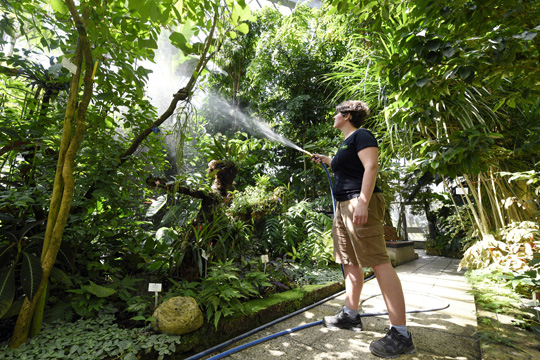
To water warm and humid biotopes such as the tropical house, the gardeners of the Botanical Garden need about three hours a day. Pictures: Thomas Kunz
Countless noises and smells flow from every corner. Plants such as cocoa and star fruit, which are originally native to distant regions of the world, grow lushly in the tropical house of the Botanical Garden. The gardeners need about three hours a day to water such a warm and humid biotope. “Everyone has their own area in our team,” explains Regina Müller. “Maintaining and watering the tropical house is one of my tasks.” Next to the Tropic House are the French Guyana House, the Succulent House and the Fern House, which according to the gardener has a very special charm: “With its fern plants, it houses living fossils that date back to the Carboniferous period about 360-300 million years ago. So here we are not only travelling around the world, but also into the past.”
Fighting drought
In the summer months many trees protect themselves from drought by shedding their leaves. However, the leaves store water and important nutrients that keep the tree healthy and alive. "A weakened tree is vulnerable to pests such as fungi or bark beetles. We therefore have to check the condition of our fosterlings regularly," explains master gardener Dirk Rohleder. His team carries out such checks at least twice a year and after special weather events such as storms and snowfall. If one of the trees can no longer be saved, it has to be felled.
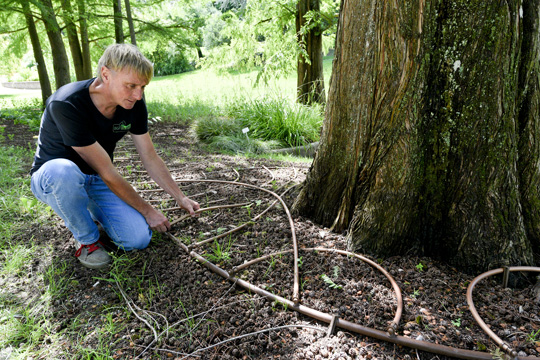
With the help of drip-tube irrigation, master gardener Dirk Rohleder supplies water to trees such as the marsh cypress, especially in times of severe drought.
The marsh cypresses in the garden also have a hard time: they come from the southern regions of North America, where it usually rains a lot. The roots of the trees spread out in a plate-like manner in the upper soil layers and absorb nutrients and water there. In the Botanical Garden, however, the shallow roots, which are often found in river deltas, do not receive enough water, partly because the groundwater level in Freiburg has been falling for years. For the marsh cypress, the gardeners therefore use drip-tube irrigation. "With the help of a hose system, which has small nozzles at 20 cm intervals, we slowly add water drops to the plant overnight. In the future we want to water the garden this way," says Rohleder. The Botanical Garden received the irrigation system as a donation from the Alumni Freiburg e.V. support association of the University of Freiburg. The horticultural team also uses the same system for pines that suffer from drought in the Alpinum, another area of the garden.
Seeds for every need
Anita Löffler-Ganter has been looking after the Alpinum with plants from mountain regions such as the Alps, the Caucasus and the Himalayas for 25 years. “The Alpinum has always been my domain. I have to do a lot of work and weeding here, but that’s what has to be done,” explains the outdoor gardener, who also looks after the Botanical Garden's seed stock. After she and her colleagues have harvested the seeds, she dries and cleans them and puts them together for seed exchange in the basement of the gardener's center. This program allows worldwide university institutions such as Botanical Gardens, medical departments or biological institutes to offer, order and exchange seeds with the help of catalogs. Löffler-Ganter receives orders and deliveries from all over the world: “But it is also particularly important to us to use our own seeds and grow them into plants.”
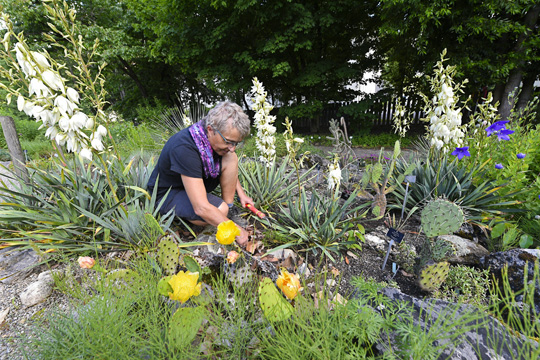
Whether Alps, Caucasus or Himalayas: outdoor gardener Anita Löffler-Ganter has been familiar with the flora of various mountain regions for 25 years.
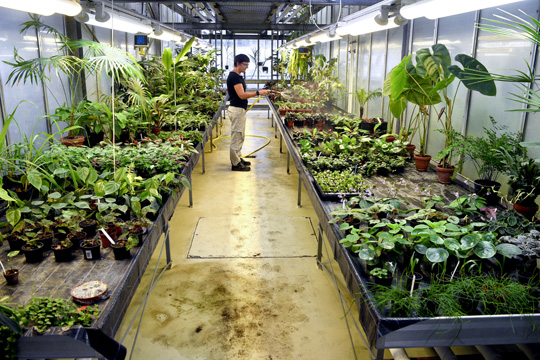
In the propagation greenhouse cells, the horticultural team propagates seeds and grows them into young plants.
The gardener center combines public greenhouses and a total of 14 propagation greenhouse cells: In these rooms the horticultural team propagates its own and cultivated seeds and grows them into young plants. The young cacti, carnivorous plants or trees, for example, are planted in the greenhouses or in the garden and made available to researchers for experiments. Visitors can marvel at the specimens on site and take home surplus plants in the entrance area in return for a voluntary donation: “The proceeds are used to pay for work equipment, special substrates or even teaching materials and trade journals for us trainees,” says Felix Schwarz, who is in his third year of training as a gardener.
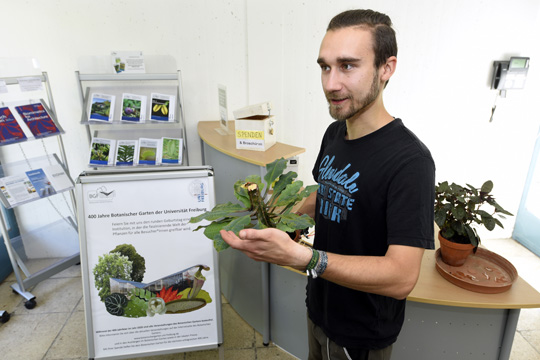
With questions around the domestic green: In the plant consulting time the trainees give helpful advice for example against pest infestation.
Weekly plant consulting
Those who do not know which plant species is on their balcony at home or which pest is infesting them can contact the gardening team every Wednesday between 2 and 4 pm. During this plant consulting time, the experts examine people's specimens and determine which plant it is or whether and how a fungal infestation can be fought for example. The task is usually performed by trainees like Schwarz: “This way we can put into practice what we have learned in theory. If we really don’t know what to do, we can look up information on the tablet or ask more experienced colleagues for help.”
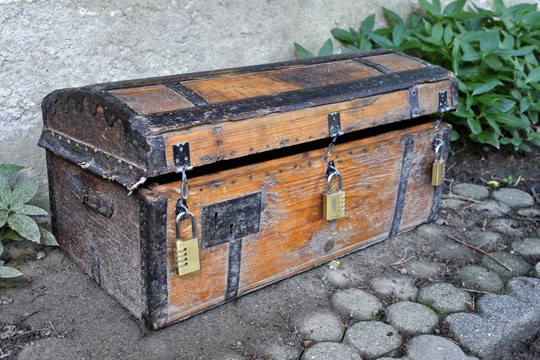
Hidden among plants: Children of different ages can examine plants, solve puzzles and even discover a treasure in the Botanical Garden.
The Botanical Garden offers guided tours on various topics such as biomimetics, plant growth forms, useful and medicinal plants, evolution of plants and movements in the plant kingdom. Dr. Friederike Gallenmüller is scientific supervisor of the Botanical Garden. She also wants to introduce the youngest members of society to the world of plants: with the so-called treasure hunts, which are designed for children of different ages. Families, birthday children with their guests or school classes can solve puzzles at several stations by finding and examining different plants. In the end, the correct solutions result in a code that can be used to open a treasure chest. Inside it are seed packets, candy or other treasures placed by the adults in advance. Gallenmüller associates a special learning goal with the concept: “We want to enable children to actively and playfully engage with the plant world of the Botanical Garden. The fact that they do this independently and without the guidance of adults plays an important role in this.”
Patrick Siegert


